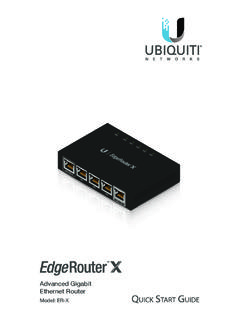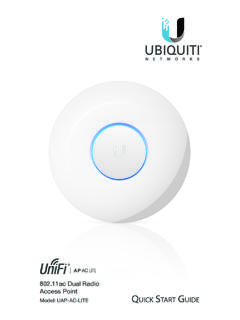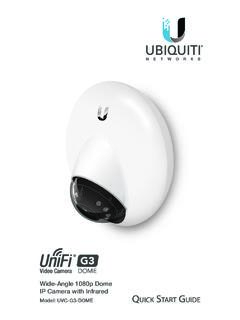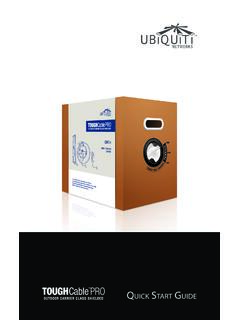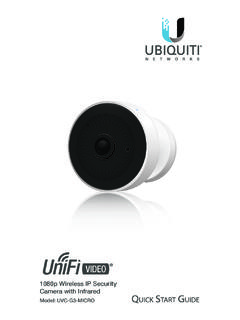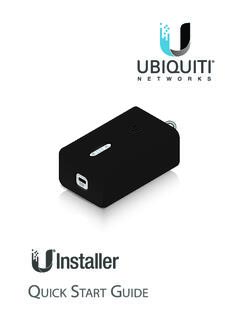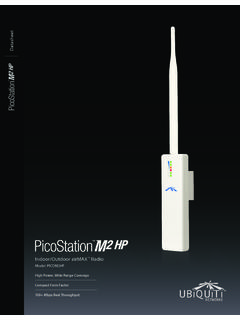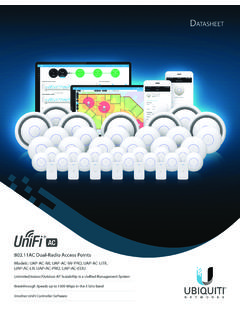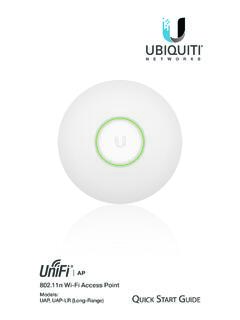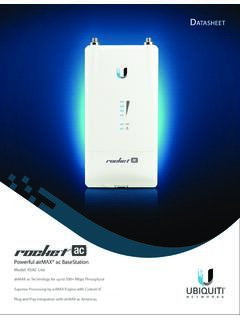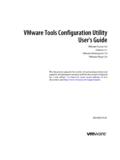Transcription of EdgeSwitch User Guide - Ubiquiti
1 configuration InterfaceRelease Version: of ContentsEdgeSwitch User GuideUbiquiti Networks, Inc .Table of ContentsChapter 1: Overview ..1 Introduction ..1 configuration ..1 configuration Interface System Requirements ..1 Chapter 2: Navigation ..3 Accessing the configuration Interface ..3 Common Interface Options ..4 Interface Screens ..5 Chapter 3: Dashboard ..7 Device Status ..8 Port Status ..8 Port Summary ..8 Chapter 4: VLANs ..13 VLANs ..13 Chapter 5: System Settings ..15 Device Name ..15 Management IP ..15 Spanning Tree Protocol ..17 Services ..17 System Actions ..18 Chapter 6: Tools ..21 MAC Table ..21 Ping ..21 Appendix A: Contact Information ..23 Ubiquiti Networks Support ..23iiTable of ContentsEdgeSwitch User GuideUbiquiti Networks, Inc .1 Chapter 1: OverviewEdgeSwitch User GuideUbiquiti Networks, 1: OverviewIntroductionThis User Guide is designed to provide details about how to set up and use the EdgeSwitch configuration Interface, version or above.
2 This interface manages the EdgeSwitch and EdgeSwitch X models, which this User Guide will collectively refer to as EdgeSwitch . The EdgeSwitch XP models use a different user interface. This is described in the EdgeSwitch XP User Guide , which is available at: intuitive interface allows you to conveniently manage your EdgeSwitch using your web browser. There are two versions available; however, this User Guide describes the default, which is the new UI with a more graphical interface. The legacy UI is still available as an option and is described in the EdgeSwitch Administration Guide , which is available at: can also manage your device using the Ubiquiti Network Management System, UNMS , which lets you configure, monitor, upgrade, and back up your devices using a single software application. To get started, go to: Interface System Requirements Linux, Mac OS X, or Microsoft Windows Web Browser: Google Chrome, Mozilla Firefox, or Apple Safari2 Chapter 1: OverviewEdgeSwitch User GuideUbiquiti Networks, User GuideUbiquiti Networks, 2: NavigationChapter 2: NavigationThe EdgeSwitch uses an advanced operating system accessed through a simple and intuitive user interface for convenient configuration and management via a web browser.
3 This interface is referred to as the configuration Interface or UI (User Interface). There are two versions of the configuration Interface. The new one is described in this User Guide . The previous one is described in the EdgeSwitch Administration Guide , which is available at: new configuration Interface is designed for basic configuration of the EdgeSwitch . If you want to configure advanced settings via the old configuration Interface or CLI, then please be aware that these advanced settings may interfere with the proper function of the new configuration Interface, and vice versa. Note: Do NOT make configuration changes using both the new interface and old interface/CLI this is NOT supported. Accessing the configuration InterfaceThe EdgeSwitch is set to DHCP by default, so it will try to automatically obtain an IP address. If that fails, then it will use the default fallback IP address, or , depending on the model number. Fallback IP AddressModel , ES-12F, ES-16-150W, ES-16-XG, ES-24-250W, ES-24-500W, ES-24-Lite, ES-48-500W, ES-48-750W, , ES-10 XPProceed to the appropriate section, DHCP or Fallback IP Address on page 4:DHCPUse one of the following methods: Set up the DHCP server to provide a specific IP address to the EdgeSwitch based on its MAC address (on the label).
4 Let the EdgeSwitch obtain an IP address and then check the DHCP server to see which IP address was log in, follow these steps:1. Launch your web browser. Type the appropriate IP address in the address field. Press enter (PC) or return (Mac). 4 EdgeSwitch User GuideUbiquiti Networks, 2: Navigation2. Enter ubnt in the Username and Password fields. Click Sign In. (When you sign in, you agree to accept the Ubiquiti License Agreement.)Note: To use the previous configuration Interface, click Go to the legacy EdgeSwitch configuration Interface will appear, allowing you to customize additional settings as can also manage your device using the Ubiquiti Network Management System. UNMS lets you configure, monitor, upgrade, and back up your devices using a single application. Get started at IP Address1. Ensure that your computer (or other host system) is connected to the Configure the Ethernet adapter on your host system with a static IP address on the Launch your web browser.
5 Type the appropriate IP address in the address field. Press enter (PC) or return (Mac). IP AddressModel , ES-12F, ES-16-150W, ES-16-XG, ES-24-250W, ES-24-500W, ES-24-Lite, ES-48-500W, ES-48-750W, , ES-10XP4. Enter ubnt in the Username and Password fields. Click Sign In. (When you sign in, you agree to accept the Ubiquiti License Agreement.)Note: To use the previous configuration Interface, click Go to the legacy The EdgeSwitch configuration Interface will appear. Click the System Settings Change the IP Address to a unique IP address. Click : If you change the IP settings, then the session will be cut off, and you will need to reconnect to the EdgeSwitch using the new IP additional settings as needed. You can also manage your device using the Ubiquiti Network Management System. UNMS lets you configure, monitor, upgrade, and back up your devices using a single application. Get started at Interface OptionsThe common interface options are accessible from the top right of the configuration Inteface.
6 UNMS User on page 55 EdgeSwitch User GuideUbiquiti Networks, 2: NavigationUNMSYou can manage your device using UNMS, which lets you configure, monitor, upgrade, and back up your devices using a single application. Click the UNMS button to visit: color of the circular icon represents the status of the connection to to UNMST rying to Connect to UNMS (Refer to the on-screen tooltip for more information)DisabledUserClick User to view the User options:Change Password Click Change Password to make a change. The Change Password screen appears: Old Password Enter the previous password. New Password Enter the new password. Confirm New Password Enter the new password again. Change Password Click to save the new Interface Click to use the previous configuration Out Click to manually log out of the EdgeSwitch configuration ScreensThe configuration Interface contains four main screens, each of which provides a web-based management page to configure a specific aspect of the EdgeSwitch .
7 This User Guide covers each main screen with a chapter. For details on a specific screen, refer to the appropriate chapter. Dashboard Dashboard on page 7 displays status information and statistics for the EdgeSwitch and each port. You can also configure port settings and Link Aggregation Groups (LAGs). VLANs VLANs on page 13 configures Virtual Local Area Networks (VLANs) for the various ports. System Settings System Settings on page 15 configures system settings and services. Tools Tools on page 21 offers the MAC forwarding table and ping test as network administration and monitoring User GuideUbiquiti Networks, 2: Navigation7 EdgeSwitch User GuideUbiquiti Networks, 3: DashboardChapter 3: DashboardThe Dashboard screen displays a summary of the link status information, current values of the basic configuration settings, network settings and information, and traffic statistics. You can also configure port Throughput Displays the throughput as related to the currently active ports and their link status information.
8 For example, if there is only one active port and it is set to 100 Mbps in full-duplex mode, then the maximum Total Throughput is 100 Mbps, shown with a complete circle. The throughput dimension (bps, kbps, Mbps) changes dynamically depending on the mean throughput value. Active Ports Displays the percentage of usage (all ports combined).Port Utilization Displays the port utilization as related to each active port and its link status information. For example, if there is only one active port and it is set to 100 Mbps in full-duplex mode, then the maximum Port Utilization is 100%, shown with a full bar to indicate the maximum theoretical utilization for the port s link state. 8 EdgeSwitch User GuideUbiquiti Networks, 3: DashboardDevice Status(Device Name) Displays the customizable name or identifier of the device. The Device Name (also known as hostname) is displayed in registration screens and discovery tools.(Uptime) This is the total time the device has been running since the latest reboot (when the device was powered up) or software upgrade.
9 The time is displayed in days, hours, minutes, and seconds.(Firmware) Displays the firmware version of the Address Displays the Media Access Control (MAC) address of the Address Displays the local IP address of the Status(Port) Displays the number of the Status Displays the speed, activity status, and PoE feature of the Mbps Link10/100 Mbps Link with PoE1000 Mbps/1 Gbps Link1000 Mbps/1 Gbps Link with PoE10 Gbps LinkDisabledDisconnectedDisconnected with PoEClick a port to access its advanced settings. Go to Advanced Settings on page 10 for more Summary(checkbox) Select multiple ports for group configuration . Aggregate If you have multiple ports selected, click Aggregate to configure LAG options for them. The LAG window appears and displays the following: -(Add) Click an existing LAG to add the selected ports. -(Create) Click the Create icon to create a new LAG. Go to Create or Edit a LAG on page 9. -(Edit) (Available if the selected ports belong to the same LAG.)
10 Click the Edit icon to configure LAG settings. Go to Create or Edit a LAG on page 9. -(Delete) (Available if the selected ports belong to the same LAG.) Move the cursor over the current LAG . When the check mark becomes an X, click it to remove the selected ports from the LAG. -(Delete from current LAGs) (Available if the selected ports belong to different LAGs.) Click the Delete icon to remove the selected ports from the current LAGs. (Advanced Settings) Configure settings for the selected ports. Go to Advanced Settings on page 10 for more Displays the number of the Name Displays the name of the port. Click to change the Displays the current RX throughput in Displays the current TX throughput in Displays the status and voltage of the PoE feature. Active PoE is displayed in blue. To disable PoE, select Off. To enable 24V passive PoE, select 24V. The default is PoE+.9 EdgeSwitch User GuideUbiquiti Networks, 3: DashboardMode (Status) Active mode is displayed in green.
